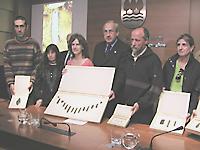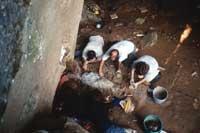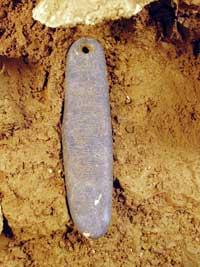Treasure of 15,500 years ago in Praile Aitz

The word sanctuary comes perfectly to the site of Praile Aitz, which is believed to be used for rites. “Those of Ekain, Altamira, etc. were the place of residence of the people, but according to the traces it can be said that they used it to do rites. That’s why it’s important because it’s different.” In total, five necklaces have been found, one with goat teeth and one with carved stones. The stones are polished and decorated with engravings and have a hole to form the necklace. One of the necklaces has 14 pieces and another has a single stone in the form of venus of 12 cm in length. All of them are very pleasant to the eye and acquire a special color if they get wet.
In addition to necklaces and venus, archaeologists have found forge, stone saddle, coal, flint openings and excavated goat bones, as well as a polished fire front seat.


The team of Xabier Peñalver began in 2000 the study of Praile Aitz, which is in a quarry in which he is working. According to the initial excavations, the cave seemed to be the residence of a group of Cro-Magnon. At first, at the entrance of the cave were found numerous remains, and Cro-Magnon was customary to make life in these surroundings of the caves. The discovery of bones, mainly goats, led researchers to the conclusion that their living beings were hunters and hunters of wild goats. Of course, once captured, they ate and accumulated the remains at the front of the cave. We also know that they went down to the river and went to the sea on tracks, as they have also found fish bones.
The current discoveries have evidently modified these first convictions and now, rather than as a place of residence, they consider it a place of encounter and rites. But one cannot say what kind of rites they did. In other sites of the same time pieces of bone have appeared and have joined the burials, but in the cave of Praile Aitz I there is no rest. The finding is very rare and unique, and it is very likely that all are pieces made by a single person based on their location and characteristics. "The cave can be a space associated with a person with a special activity or capacity."
Living environment

Praile is located between Deba and Mendaro, in a slope area very difficult to access. Numerous caves of the Upper Palaeolithic have been found in this area. On the same slope there was another cave called Praile Aitz II that disappeared due to the works of the quarry. If the trees did not avoid it, from Praile Aitze you would see the caves of Ermittia, Iruroin and Langatxo.
Barandiarán and Aranzadi analyzed the cave of Ermittia between 1924 and 1926 and recovered a very important material. Iruroin and Langatxo were excavated in the 1990s, such as Praile Aitz II. This type of congestion indicates that Bajo Deba was highly appreciated by Upper Palaeolithic humans. It should be noted that the Madeleine period coincided with that of the last glaciation, and that at that time it did not even remove the snow in places higher than 1,000 meters. Therefore, Cro-Magnon was looking for valleys with protection, low altitude and close to the sea. “The real treasure is that this is a set of deposits of this type, which helps us to have a certain global vision.” And the intention of the researchers goes beyond finding surprising tools and materials, especially they want to know how it was and how those who lived thousands of years ago lived.
Buletina
Bidali zure helbide elektronikoa eta jaso asteroko buletina zure sarrera-ontzian











